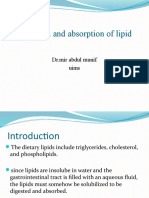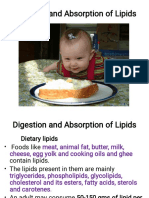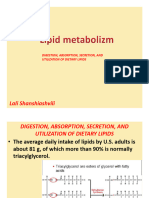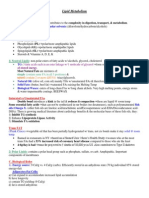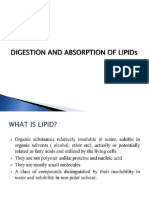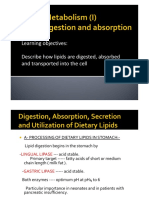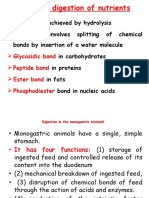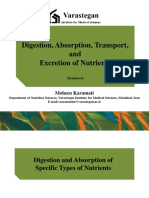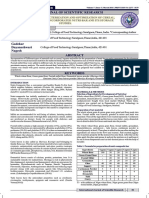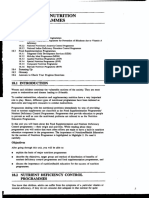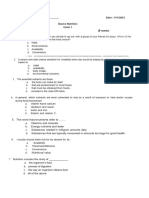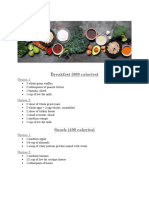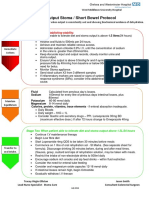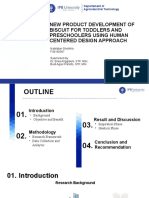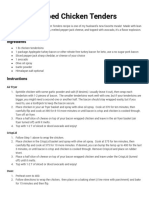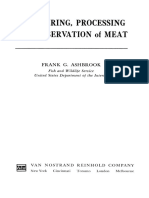0 ratings0% found this document useful (0 votes)
33 viewsCh15 Metabolism of Dietary Lipids
Ch15 Metabolism of Dietary Lipids
Uploaded by
Wahab KhaniThis document summarizes lipid metabolism, focusing on the digestion, absorption, and utilization of dietary lipids. It describes how lipids are broken down by lipases in the stomach and pancreas into fatty acids, monoacylglycerols, and other components. These are absorbed via micelles into intestinal cells and reassembled into triglycerides and other lipids for transport to other tissues. Deficiencies in this process can lead to lipid malabsorption and excess fat in stool.
Copyright:
© All Rights Reserved
Available Formats
Download as PPT, PDF, TXT or read online from Scribd
Ch15 Metabolism of Dietary Lipids
Ch15 Metabolism of Dietary Lipids
Uploaded by
Wahab Khani0 ratings0% found this document useful (0 votes)
33 views37 pagesThis document summarizes lipid metabolism, focusing on the digestion, absorption, and utilization of dietary lipids. It describes how lipids are broken down by lipases in the stomach and pancreas into fatty acids, monoacylglycerols, and other components. These are absorbed via micelles into intestinal cells and reassembled into triglycerides and other lipids for transport to other tissues. Deficiencies in this process can lead to lipid malabsorption and excess fat in stool.
Copyright
© © All Rights Reserved
Available Formats
PPT, PDF, TXT or read online from Scribd
Share this document
Did you find this document useful?
Is this content inappropriate?
This document summarizes lipid metabolism, focusing on the digestion, absorption, and utilization of dietary lipids. It describes how lipids are broken down by lipases in the stomach and pancreas into fatty acids, monoacylglycerols, and other components. These are absorbed via micelles into intestinal cells and reassembled into triglycerides and other lipids for transport to other tissues. Deficiencies in this process can lead to lipid malabsorption and excess fat in stool.
Copyright:
© All Rights Reserved
Available Formats
Download as PPT, PDF, TXT or read online from Scribd
Download as ppt, pdf, or txt
0 ratings0% found this document useful (0 votes)
33 views37 pagesCh15 Metabolism of Dietary Lipids
Ch15 Metabolism of Dietary Lipids
Uploaded by
Wahab KhaniThis document summarizes lipid metabolism, focusing on the digestion, absorption, and utilization of dietary lipids. It describes how lipids are broken down by lipases in the stomach and pancreas into fatty acids, monoacylglycerols, and other components. These are absorbed via micelles into intestinal cells and reassembled into triglycerides and other lipids for transport to other tissues. Deficiencies in this process can lead to lipid malabsorption and excess fat in stool.
Copyright:
© All Rights Reserved
Available Formats
Download as PPT, PDF, TXT or read online from Scribd
Download as ppt, pdf, or txt
You are on page 1of 37
UNIT III:
Lipid Metabolism
Metabolism of Dietary Lipids
Overview
• Lipids: a heterogeneous group of hydrophobic
organic molecules that can be extracted from tissues
by non-polar solvents.
• Because of insolubility in aqueous solutions, body
lipids are generally found compartmentalized, as in
the case of membrane-associated lipids or droplets of
triacylglycerol in adipocytes, or transported in plasma
in association with protein, as in lipoprotein particles,
or on albumin.
• Lipids are a major source of energy for the body, and
they also provide the hydrophobic barrier that permits
partitioning of the aqueous contents of cells and
subcellular structures.
• Lipids serve additional functions in the body, e.g., some
fat-soluble vitamins have regulatory or coenzyme
functions, and the prostaglandins and steroid hormones
play major roles in the control of the body's homeostasis.
• Deficiencies or imbalances of lipid metabolism can lead
to some of the major clinical problems such as
atherosclerosis and obesity.
Figure 15.1. Structures of some common classes of lipids.
Hydrophobic portions of the molecules are shown in orange.
Figure 15.1. Structures of some common classes of lipids.
Hydrophobic portions of the molecules are shown in orange.
II. Digestion, Absorption, Secretion, and
Utilization of Dietary Lipids
• The average daily intake of lipids by U.S. adults is
about 81 g, of which more than 90% is normally
triacylglycerol (TAG).
• The remainder of the dietary lipids consists primarily of
cholesterol, cholesteryl esters, phospholipids, and
unesterified (“free”) fatty acids.
A. Processing of dietary lipid in the stomach
• The digestion of lipids begins in the stomach,
catalyzed by an acid-stable lipase that
originates from glands at the back of the
tongue (lingual lipase).
• TAG molecules, particularly those containing
fatty acids of short- or medium-chain length are
the primary target of this enzyme.
– These same TAGs are also degraded by a separate
gastric lipase, secreted by the gastric mucosa.
• Both enzymes are relatively acid-stable, with pH
optimums of pH 4 to pH 6. These “acid lipases”
play a particularly important role in lipid digestion
in neonates, for whom milk fat is the primary
source of calories.
• They are also important digestive enzymes in
individuals with pancreatic insufficiency, such as
those with cystic fibrosis.
• Lingual and gastric lipases aid these patients in
degrading TAG molecules (especially those with
short- to medium-chain fatty acids) despite a
near or complete absence of pancreatic lipase.
B. Emulsification of dietary lipid in the small intestine
• Emulsification of dietary lipids occurs in the duodenum. It
increases the surface area of the hydrophobic lipid droplets so
that the digestive enzymes, which work at the interface of the
droplet and the surrounding aqueous solution, can act
effectively.
• Emulsification is accomplished by two complementary
mechanisms, use of detergent properties of the bile salts, and
mechanical mixing due to peristalsis.
• Bile salts, made in the liver and stored in the gallbladder, are
derivatives of cholesterol. They consist of a sterol ring structure
with a side chain to which a molecule of glycine or taurine is
covalently attached by an amide linkage.
• These emulsifying agents interact with the dietary lipid particles
and the aqueous duodenal contents, thereby stabilizing the
particles as they become smaller, and preventing them from
coalescing.
Figure 15.3. Structure of glycocholic acid.
C. Degradation of dietary lipids by pancreatic enzymes
• The dietary TAG, cholesteryl esters, and phospholipids
are enzymically degraded by pancreatic enzymes,
whose secretion is hormonally controlled.
1. TAG degradation:
• TAG molecules are too large to be taken up efficiently by
the mucosal cells of the intestinal villi. They are,
therefore, acted upon by an esterase, pancreatic lipase,
which preferentially removes the fatty acids at carbons 1
and 3.
• The primary products of hydrolysis are thus a mixture of
2-monoacylglycerol and free fatty acids.
• A second protein, colipase, also secreted by the
pancreas, binds the lipase at a ratio of 1:1, and
anchors it at the lipid-aqueous interface. There it
causes a conformational change in the lipase
that exposes its active site.
[Note: Colipase is secreted as the zymogen,
procolipase, which is activated in the intestine by
trypsin.]
• Orlistat, an antiobesity drug, inhibits gastric and
pancreatic lipases, thereby decreasing fat
absorption, resulting in loss of weight.
2. Cholesteryl ester degradation:
• Most dietary cholesterol is present in the free
(non-esterified) form, with 10–15% present in the
esterified form.
• Cholesteryl esters are hydrolyzed by pancreatic
cholesteryl ester hydrolase (cholesterol
esterase), which produces cholesterol plus free
fatty acids.
• Cholesteryl ester hydrolase activity is greatly
increased in the presence of bile salts.
3. Phospholipid degradation:
• Pancreatic juice is rich in the proenzyme of
phospholipase A2 that, like procolipase, is activated by
trypsin and, like cholesteryl ester hydrolase, requires bile
salts for optimum activity.
• Phospholipase A2 removes one fatty acid from carbon 2
of a phospholipid, leaving a lysophospholipid. E.g.,
phosphatidylcholine (the predominant phospholipid
during digestion) becomes lysophosphatidylcholine. The
remaining fatty acid at carbon 1 can be removed by
lysophospholipase, leaving a glycerylphosphoryl base
(e.g., glycerylphosphorylcholine) that may be excreted in
the feces, further degraded, or absorbed.
4. Control of lipid digestion:
• Pancreatic secretion of the hydrolytic enzymes that
degrade dietary lipids in the small intestine is hormonally
controlled.
• Cells in the mucosa of the jejunum and lower duodenum
produce a small peptide hormone, cholecystokinin
(CCK), in response to the presence of lipids and partially
digested proteins entering these regions of the upper
small intestine. CCK acts on the gallbladder (causing it to
contract and release bile—a mixture of bile salts,
phospholipids, and free cholesterol), and on the exocrine
cells of the pancreas (causing them to release digestive
enzymes).
• It also decreases gastric motility, resulting in a slower
release of gastric contents into the small intestine.
• Other intestinal cells produce another small peptide
hormone, secretin, in response to the low pH of the
chyme entering the intestine.
• Secretin causes the pancreas and the liver to release a
watery solution rich in bicarbonate that helps neutralize
the pH of the intestinal contents, bringing them to the
appropriate pH for digestive activity by pancreatic
enzymes.
Figure 15.4 Hormonal control
of lipid digestion in the small
intestine.
D. Absorption of lipids by intestinal mucosal cells
(enterocytes)
• Free fatty acids, free cholesterol, and 2-
monoacylglycerol are the primary products of lipid
digestion in the jejunum. These, plus bile salts and fat-
soluble vitamins, form mixed micelles—disk-shaped
clusters of amphipathic lipids that coalesce with their
hydrophobic groups on the inside and their hydrophilic
groups on the outside.
• Mixed micelles are, therefore, soluble in the aqueous
environment of the intestinal lumen. These particles
approach the primary site of lipid absorption, the brush
border membrane of the enterocytes (mucosal cell). This
membrane is separated from the liquid contents of the
intestinal lumen by an unstirred water layer that mixes
poorly with the bulk fluid.
• The hydrophilic surface of the micelles facilitates the
transport of the hydrophobic lipids through the unstirred
water layer to the brush border membrane where they
are absorbed.
• Short- and medium-chain length fatty acids do not
require the assistance of mixed micelles for absorption
by the intestinal mucosa.
[Note: Relative to other dietary lipids, cholesterol is only
poorly absorbed by the enterocytes. Drug therapy (for
example, with ezetimibe) can further reduce cholesterol
absorption in the small intestine.]
Figure 15.5 Absorption of lipids
contained in a mixed micelle by an
intestinal mucosal cell.
E. Resynthesis of TAG and cholesteryl esters
• The mixture of lipids absorbed by the enterocytes migrates
to the endoplasmic reticulum where biosynthesis of
complex lipids takes place. Fatty acids are first converted
into their activated form by fatty acyl-CoA synthetase
(thiokinase).
• Using the fatty acyl CoA derivatives, the 2-
monoacylglycerols absorbed by the enterocytes are
converted to TAGs by the enzyme complex, TAG
synthase. This complex synthesizes TAG by the
consecutive actions of two enzyme activities—acyl
CoA:monoacylglycerol acyltransferase and acyl
CoA:diacylglycerol acyltransferase.
• Lysophospholipids are reacylated to form
phospholipids by a family of acyltransferases,
and cholesterol is esterified to a fatty acid
primarily by acyl CoA:cholesterol
acyltransferase.
• [Note: Virtually all long-chain fatty acids entering
the enterocytes are used in this fashion to form
TAGs, phospholipids, and cholesteryl esters.
Short- and medium-chain length fatty acids are
not converted to their CoA derivatives, and are
not reesterified to 2-monoacylglycerol. Instead,
they are released into the portal circulation,
where they are carried by serum albumin to the
liver.]
Figure 15.6 Assembly and secretion of chylomicrons by
intestinal mucosal cells.
F. Lipid malabsorption
• Lipid malabsorption, resulting in increased lipid (including
the fat-soluble vitamins A, D, E, and K, and essential
fatty acids) in the feces (that is, steatorrhea), can be
caused by disturbances in lipid digestion and/or
absorption.
• Such disturbances can result from several conditions,
including CF (causing poor digestion) and shortened
bowel (causing decreased absorption).
• The ability of short- and medium-chain fatty acids to be
taken up by enterocytes without the aid of mixed
micelles has made them important in dietary therapy for
individuals with malabsorption disorders.
Possible causes of steatorrhea.
G. Secretion of lipids from enterocytes
• The newly synthesized TAGs and cholesteryl esters are
very hydrophobic, and aggregate in an aqueous
environment.
• It is, therefore, necessary that they be packaged as
particles of lipid droplets surrounded by a thin layer
composed of phospholipids, unesterified cholesterol,
and a molecule of the characteristic protein,
apolipoprotein B-48. This layer stabilizes the particle
and increases its solubility, thereby preventing multiple
particles from coalescing.
• [Note: Microsomal TAG transfer protein is essential for
the assembly of these TAG-rich apolipoprotein B–
containing lipoprotein particles in the endoplasmic
reticulum.]
• The particles are released by exocytosis from
enterocytes into the lacteals (lymphatic vessels
originating in the villi of the small intestine). The
presence of these particles in the lymph after a lipid-
rich meal gives it a milky appearance.
• This lymph is called chyle, and the particles are
named chylomicrons. Chylomicrons follow the
lymphatic system to the thoracic duct, and are then
conveyed to the left subclavian vein, where they
enter the blood. The steps in the production of
chylomicrons are summarized in the following figure:
H. Use of dietary lipids by the tissues
• Triacylglycerol contained in chylomicrons is broken down
primarily in the capillaries of skeletal muscle and adipose
tissues, but also those of the heart, lung, kidney, and
liver.
• Triacylglycerol in chylomicrons is degraded to free fatty
acids and glycerol by lipoprotein lipase. This enzyme is
synthesized primarily by adipocytes and muscle cells. It
is secreted and becomes associated with the luminal
surface of endothelial cells of the capillary beds of the
peripheral tissues.
• [Note: Familial lipoprotein lipase deficiency (type I
hyperlipoproteinemia) is a rare, autosomal recessive
disorder caused by a deficiency of lipoprotein lipase or
its coenzyme, apolipoprotein C-II. The result is fasting
chylomicronemia and hypertriacylglycerolemia.]
1. Fate of free fatty acids: The free fatty acids derived from
the hydrolysis of TAG may directly enter adjacent muscle
cells or adipocytes. Alternatively, the free fatty acids may
be transported in the blood in association with serum
albumin until they are taken up by cells.
[Note: Serum albumin is a large protein secreted by the
liver. It transports a number of primarily hydrophobic
compounds in the circulation, including free fatty acids
and some drugs]. Most cells can oxidize fatty acids to
produce energy. Adipocytes can also re-esterify free
fatty acids to produce TAG molecules, which are stored
until the fatty acids are needed by the body.
2. Fate of glycerol: Glycerol that is released from TAG is
used almost exclusively by the liver to produce glycerol
3-phosphate, which can enter either glycolysis or
gluconeogenesis by oxidation to dihydroxyacetone
phosphate.
3. Fate of the remaining chylomicron components: After
most of the TAG has been removed, the chylomicron
remnants (which contain cholesteryl esters,
phospholipids, apolipoproteins, fat-soluble vitamins,
and some TAG) bind to receptors on the liver and are
then endocytosed. The remnants are then hydrolyzed
to their component parts. Cholesterol and the
nitrogenous bases of phospholipids (for example,
choline) can be recycled by the body.
[Note: If removal of chylomicron remnants by the liver is
defective, they accumulate in the plasma. This is seen
in Type III hyperlipoproteinemia (also called familial
dysbetalipoproteinemia).
III. Chapter Summary
• The digestion of dietary lipids begins in the stomach and continues
in the small intestine.
• The hydrophobic nature of lipids requires that the dietary lipids—
particularly those that contain long-chain length fatty acids (LCFA)—
be emulsified for efficient degradation.
• Triacylglycerols (TAG) obtained from milk contain short- to medium-
chain length fatty acids that can be degraded in the stomach by the
acid lipases (lingual lipase and gastric lipase).
• Cholesteryl esters (CE), phospholipids (PL), and TAG containing
LCFAs are degraded in the small intestine by enzymes secreted by
the pancreas.
• The most important of these enzymes are pancreatic lipase,
phospholipase A2, and cholesteryl esterase.
• The dietary lipids are emulsified in the small intestine using
peristaltic action, and bile salts, which serve as a detergent.
• The products resulting from enzymatic degradation of
dietary lipid are 2-monoacylglycerol, unesterified
cholesterol, and free fatty acids (plus some fragments
remaining from PL digestion).
• These compounds, plus the fat-soluble vitamins, form
mixed micelles that facilitate the absorption of dietary
lipids by intestinal mucosal cells (enterocytes). These
cells resynthesize TAG, CE, and PL, and also synthesize
protein (apolipoprotein B-48), all of which are then
assembled with the fat-soluble vitamins into
chylomicrons.
• These serum lipoprotein particles are released into the
lymph, which carries them to the blood. Thus, dietary
lipids are transported to the peripheral tissues. A
deficiency in the ability to degrade chylomicron
components, or remove their remnants after TAG has
been removed, results in accumulation of these particles
in blood.
You might also like
- Digestion and Absorption in The Gastrointestinal Tract-Summary of GuytonDocument7 pagesDigestion and Absorption in The Gastrointestinal Tract-Summary of GuytonLeira Lee100% (1)
- Week 6 LipidsDocument59 pagesWeek 6 Lipidsbo aNo ratings yet
- Lipids Digestion and AbsorptionDocument28 pagesLipids Digestion and AbsorptionEng Matti Ur RehmanNo ratings yet
- Lipid: Chemistry and MetabolismDocument68 pagesLipid: Chemistry and MetabolismLyra GetNo ratings yet
- Lipid DigestiDocument5 pagesLipid DigestiKahsuNo ratings yet
- Metabolism of LipidsDocument37 pagesMetabolism of LipidsSafura IjazNo ratings yet
- Wa0009.Document29 pagesWa0009.অণ্যরকম BDNo ratings yet
- Digestion, Absorption and Utilization of LipidsDocument15 pagesDigestion, Absorption and Utilization of LipidsBalram NeupaneNo ratings yet
- Digestion and Absorption of Dietary LipidsDocument35 pagesDigestion and Absorption of Dietary LipidsCharmaine Luc100% (2)
- Digestion and Absorption of Lipid 12Document36 pagesDigestion and Absorption of Lipid 12Pranjul MishraNo ratings yet
- 9................ Lecture 9 by MullerDocument131 pages9................ Lecture 9 by MullerTariku BogaleNo ratings yet
- 6.digetion of LipidsDocument23 pages6.digetion of LipidsMilkoo sabaNo ratings yet
- Lipid Digestion and AbsorptionDocument72 pagesLipid Digestion and AbsorptionKavya GaneshNo ratings yet
- Card 3 Digestion Absorption Metabolism 5512Document210 pagesCard 3 Digestion Absorption Metabolism 5512Suraiya IslamNo ratings yet
- Cholesterol, Bile SaltsDocument94 pagesCholesterol, Bile SaltsMax Annani-akollor100% (1)
- Lipid MetabolismDocument134 pagesLipid MetabolismEmmaNo ratings yet
- BiochemDocument10 pagesBiochemWaseem Abbas ShaikhNo ratings yet
- Lipid Metabolism: Hirowati AliDocument39 pagesLipid Metabolism: Hirowati Alinajdah fakhirahNo ratings yet
- Guc 2705 59 28561 2023-05-18T10 45 27Document47 pagesGuc 2705 59 28561 2023-05-18T10 45 27malak00mohamed229No ratings yet
- Biochemical Aspects of Digestion of Lipids: Dr. Amr S. MoustafaDocument30 pagesBiochemical Aspects of Digestion of Lipids: Dr. Amr S. Moustafaraanja2No ratings yet
- Lipids NotesDocument4 pagesLipids NoteskatNo ratings yet
- Biochemical Digestive and Absorption Process of Dietary-Sunarti-Biochemistry (2015)Document36 pagesBiochemical Digestive and Absorption Process of Dietary-Sunarti-Biochemistry (2015)nayanikatesalonikaNo ratings yet
- 2.2. Digestion, Absorption, Secretion, and Utilization of Dietary LipidsDocument45 pages2.2. Digestion, Absorption, Secretion, and Utilization of Dietary LipidsAna AbuladzeNo ratings yet
- Metabolism of LipidsDocument96 pagesMetabolism of LipidsLyra GetNo ratings yet
- Rlesson 221 Digestion and Absorption of Lipids 1Document15 pagesRlesson 221 Digestion and Absorption of Lipids 1benjamingodson49No ratings yet
- Digestion and Absorption of LipidsDocument17 pagesDigestion and Absorption of Lipidsjinayahhh2No ratings yet
- Lipid Metabolism NotesDocument17 pagesLipid Metabolism NotesLucy ZuluNo ratings yet
- Lipid Metabolism NotesDocument17 pagesLipid Metabolism Notessean71% (7)
- 2.LIPIDS DigestionDocument21 pages2.LIPIDS DigestionAlaa Hisham100% (1)
- 4 of 7 Metabolism of LipidsDocument84 pages4 of 7 Metabolism of LipidsImad khanNo ratings yet
- Lipid MetabolismDocument15 pagesLipid MetabolismMUTHONI IRERINo ratings yet
- Fall 2007 Lecture 34Document6 pagesFall 2007 Lecture 34Yogesh BarvaliyaNo ratings yet
- Digestion and Absorption of FatsDocument8 pagesDigestion and Absorption of Fatsynk8vqzyrsNo ratings yet
- Lipid Metabolism: Prof. Talal Abdulrazzaq AlkawryDocument39 pagesLipid Metabolism: Prof. Talal Abdulrazzaq AlkawryRami GhalibNo ratings yet
- Lipid Metabolism 1Document61 pagesLipid Metabolism 1pierrewambura123No ratings yet
- Digestion and Absorption of Lipids NotesDocument38 pagesDigestion and Absorption of Lipids NotesZulfiqar AliNo ratings yet
- Name: Geonyzl L. Alviola Date: September 09, 2016 Subject: Chemical PhysiologyDocument38 pagesName: Geonyzl L. Alviola Date: September 09, 2016 Subject: Chemical PhysiologyMeeshaNo ratings yet
- Carbohydrate, Protein and Lipid Metabolism-B.NDocument77 pagesCarbohydrate, Protein and Lipid Metabolism-B.NBusy worldNo ratings yet
- The Biochemistry of Digestion, Absorption and Detoxification by Prof. Dr. Hedef D. El-YassinDocument64 pagesThe Biochemistry of Digestion, Absorption and Detoxification by Prof. Dr. Hedef D. El-YassinSayhidoen CepexNo ratings yet
- Bile Acid MetabolismDocument34 pagesBile Acid Metabolismsefrounf100% (1)
- Digestion and Absorption of LipidsDocument5 pagesDigestion and Absorption of LipidsAngelo Jude Cobacha100% (1)
- Digestion of Fats (Triglycerides/Lipids) : By: Brittany Speer, William Mcnees, Peter Schulz, Maiko Ibay, and Regina TabiDocument31 pagesDigestion of Fats (Triglycerides/Lipids) : By: Brittany Speer, William Mcnees, Peter Schulz, Maiko Ibay, and Regina Tabikhaer udinNo ratings yet
- 7.2 Lipids Digestion&absorptionDocument36 pages7.2 Lipids Digestion&absorptionAshria Sonali PrakashNo ratings yet
- Lipid Metabolism (I) - Lipid Digestion and AbsorptionDocument18 pagesLipid Metabolism (I) - Lipid Digestion and Absorptionlightning proNo ratings yet
- Lipoprotein MetabolismDocument3 pagesLipoprotein MetabolismMika AndyNo ratings yet
- 8 Lipid MetabolismDocument75 pages8 Lipid MetabolismJumana AlsolamiNo ratings yet
- Assignment Mammalian Physiology: Topic:-Mechanism of Digestion ForDocument6 pagesAssignment Mammalian Physiology: Topic:-Mechanism of Digestion ForRajkamal SarmaNo ratings yet
- Lipid Metabolism Session 1Document34 pagesLipid Metabolism Session 1KundaNo ratings yet
- BCH 2212 - For Anatomy and Physiology - 084524Document63 pagesBCH 2212 - For Anatomy and Physiology - 084524Aminu IbrahimNo ratings yet
- Absorption of LipidsDocument2 pagesAbsorption of LipidsAwwal AderinkolaNo ratings yet
- Lipid Metabolism Dental and PhysiotherapyDocument43 pagesLipid Metabolism Dental and PhysiotherapyNada Atef KoraitemNo ratings yet
- 3 7-CatabolismDocument66 pages3 7-CatabolismAlondra SagarioNo ratings yet
- DigestionDocument21 pagesDigestionAndersonNo ratings yet
- Session 6 Digestion Absorbtion Transport and Excretion of Nutrients PDFDocument63 pagesSession 6 Digestion Absorbtion Transport and Excretion of Nutrients PDFAbubakar SuleimanNo ratings yet
- Secretion of Bile and The Role of Bile Acids in DigestionDocument8 pagesSecretion of Bile and The Role of Bile Acids in DigestionMarianne Kristelle NonanNo ratings yet
- Digestion of LipidsDocument19 pagesDigestion of LipidsSatvikaNo ratings yet
- Lecture 7.1 Lipid MetabolismDocument7 pagesLecture 7.1 Lipid MetabolismHuzaifa MehmoodNo ratings yet
- 2020 The Essential Diets - All Diets in One Book - Ketogenic, Mediterranean, Mayo, Zone Diet, High Protein, Vegetarian, Vegan, Detox, Paleo, Alkaline Diet and Much More: COOKBOOK, #2From Everand2020 The Essential Diets - All Diets in One Book - Ketogenic, Mediterranean, Mayo, Zone Diet, High Protein, Vegetarian, Vegan, Detox, Paleo, Alkaline Diet and Much More: COOKBOOK, #2No ratings yet
- Hypovitaminosis D in Adult - A Systemic ReviewDocument8 pagesHypovitaminosis D in Adult - A Systemic ReviewWahab KhaniNo ratings yet
- UrineDocument41 pagesUrineWahab KhaniNo ratings yet
- Microbial EcologyDocument49 pagesMicrobial EcologyWahab KhaniNo ratings yet
- Antibiotic Mechanisms (For Students)Document87 pagesAntibiotic Mechanisms (For Students)Wahab KhaniNo ratings yet
- Bukya, Ankush, Nagesh - 2018 - Characterization and Optimization of Cereal, Legume and Millet Incorporated Nutri-Bar and Its Storage-AnnotatedDocument4 pagesBukya, Ankush, Nagesh - 2018 - Characterization and Optimization of Cereal, Legume and Millet Incorporated Nutri-Bar and Its Storage-AnnotatedArjun SinghNo ratings yet
- Practical 2 SheetDocument9 pagesPractical 2 SheetNur IzzatiNo ratings yet
- Unit Major Nutrition Programmes: StructureDocument23 pagesUnit Major Nutrition Programmes: StructureManjula AkkaragalNo ratings yet
- Daily Test of English UNIT 3 Class 5 - Google FormsDocument11 pagesDaily Test of English UNIT 3 Class 5 - Google Formskirixoke5581No ratings yet
- Globalization in Eating HabitsDocument16 pagesGlobalization in Eating Habitsarshia nikithaNo ratings yet
- Basic Nutrition Exam 1Document3 pagesBasic Nutrition Exam 1Naqaa AlomariNo ratings yet
- Luvele Yogurt Maker ManualDocument8 pagesLuvele Yogurt Maker ManualvvhirondelleNo ratings yet
- 2800 CalsDocument3 pages2800 CalsRaaj AaryanNo ratings yet
- Grade 7Document7 pagesGrade 7Mojtaba HekmatniaNo ratings yet
- Lesson 3 Techniques in Summarizing Variety of Academic TextsDocument21 pagesLesson 3 Techniques in Summarizing Variety of Academic Textschen11ogalescoNo ratings yet
- @ Dietary Components and Immune Function Nutrition and Health PDFDocument701 pages@ Dietary Components and Immune Function Nutrition and Health PDFsmileyesthiNo ratings yet
- Bbdm3033 Cw1 Rbfy2s2g2 Group2 ChristyDocument14 pagesBbdm3033 Cw1 Rbfy2s2g2 Group2 Christychristyyjx-wp20No ratings yet
- High Output Stoma Protocol 2017Document1 pageHigh Output Stoma Protocol 2017AFH12No ratings yet
- New Product Development of Biscuit For Toddlers and Preschoolers Using Human Centered Design ApproachDocument22 pagesNew Product Development of Biscuit For Toddlers and Preschoolers Using Human Centered Design ApproachSiti Khodijah PurbasariNo ratings yet
- Sample English MockDocument9 pagesSample English MockBeast PlayzNo ratings yet
- Bacon Wrapped Chicken TendersDocument2 pagesBacon Wrapped Chicken TendersDanielaNo ratings yet
- Development and Evaluation of Gluten-Free Multi-Grain Health MixDocument8 pagesDevelopment and Evaluation of Gluten-Free Multi-Grain Health MixDanaNo ratings yet
- Experiment 1 CheeseDocument5 pagesExperiment 1 CheesePio ManaguelodNo ratings yet
- Senegal's Policies To Reduce Malnt PDFDocument38 pagesSenegal's Policies To Reduce Malnt PDFJacopo SegniniNo ratings yet
- AnishnaabemowinDocument11 pagesAnishnaabemowinRanaNo ratings yet
- Animal Nutrition Dissertation IdeasDocument8 pagesAnimal Nutrition Dissertation IdeasNeedHelpWriteMyPaperDesMoines100% (1)
- Conchem q2 mdl1Document27 pagesConchem q2 mdl1Zehn Ollie DabuNo ratings yet
- Bridgit Danner Toxic Mold Detox ProtocolsDocument12 pagesBridgit Danner Toxic Mold Detox ProtocolsDrNicole Barssoum100% (1)
- Cognitive PsychologyDocument21 pagesCognitive PsychologyMaha KhanNo ratings yet
- Butchering, Processing and Preservation of MeatDocument327 pagesButchering, Processing and Preservation of MeatOliver KlaussNo ratings yet
- Chapter 5Document81 pagesChapter 5May Angela CostalesNo ratings yet
- The Dawn of A Plant Based AgeDocument52 pagesThe Dawn of A Plant Based AgePune Vegans100% (1)
- Quiz 3 Q1Document2 pagesQuiz 3 Q1rbatangantang100% (1)
- Precision Engineering Solution Pvt. LTD.: Lalitpur, NepalDocument11 pagesPrecision Engineering Solution Pvt. LTD.: Lalitpur, NepalShyam ShrishNo ratings yet
- Nutrition and DieteticsDocument203 pagesNutrition and Dieteticsலலிதா மீனாட்சிசுந்தரம்No ratings yet









